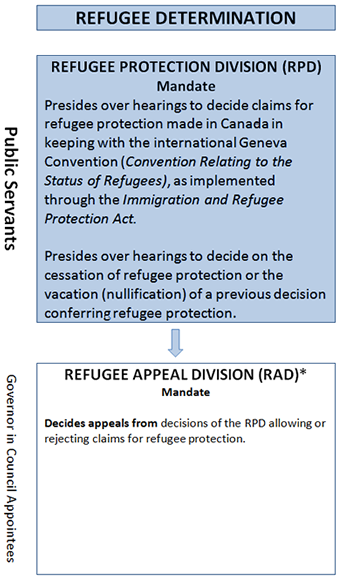
[Alternate format]
- The image above describes the In-Canada Asylum determination system.
- The figure encompasses a flowchart consisting of two boxes, one atop the other, connected with an arrow.
- The box on the top has text beside it that indicates that Refugee Protection Division (RPD) Members are public servants. Inside the box, it states that the Refugee Protection Division’s (RPD) mandate is to preside over hearings to decide claims for refugee protection made in Canada in keeping with the international Geneva Convention (Convention Relating to the Status of Refugees), as implemented through the
Immigration and Refugee Protection Act and to preside over hearings to decide on the cessation of refugee protection or the vacation (nullification) of a previous decision conferring refugee protection.
- An arrow centered in the middle, pointing down, connects the box on the top with the box on the bottom.
- The box on the bottom has text beside it that indicates that Refugee Appeal Division (RAD) Members are Governor in Council Appointees. Inside the box, it states that Refugee Appeal Division (RAD) mandate is to decide appeals from decisions of the RPD allowing or rejecting claims for refugee protection.
.png)
[Alternate format]
- The image above describes the Immigration matters that are heard before the Immigration and Refugee Board of Canada.
- The figure encompasses a flowchart consisting of two boxes, one atop the other, connected with an arrow.
- The box on the top has text beside it that indicates that Immigration Division (ID) Members are public servants. Inside the box, it states that the Immigration Division’s (ID) mandate is to preside over detention review hearings to decide on the continued detention or release of persons who are detained by the Canada Border Services Agency under the
Immigration and Refugee Protection Act and to preside over hearings to decide on the admissibility of foreign nationals and permanent residents who are alleged to be inadmissible to Canada.
- An arrow oriented to the right, pointing down, connects the box on the top with the box on the bottom. The arrow is oriented to the right because the box below is split in two; the arrow only connects to the right portion of the box that is split to denote that the Immigration Appeal Division’s (IAD) appellate function over the Immigration Division (ID) is confined to decisions of the ID on matters of admissibility.
- The box on the bottom has text beside it that indicates that Immigration Appeal Division (IAD) Members are Governor in Council Appointees.
- The box on the bottom is split in two. On the left, not connected with any arrow from above, states that the Immigration Appeal Division’s (IAD) mandate is to decide appeals from decisions by Immigration, Refugees, and Citizenship Canada (IRCC) refusing family sponsorship applications; decisions to make certain removal orders against permanent residents, protected persons, and holders of permanent resident visas and decisions by IRCC regarding the failure of a permanent resident to meet the residency obligation. On the right, connected by the arrow from the box above, states that the Immigration Appeal Division’s (IAD) mandate is also to decide appeals from decisions by the ID on admissibility.
The Immigration and Refugee Board of Canada (IRB)
The IRB is Canada’s largest independent administrative tribunal and operates at arms-length from government. It is comprised of four tribunals or “Divisions” as shown above. All four tribunals employ independent decision makers or “Members”. You are applying to the
Refugee Protection Division (RPD) or the
Immigration Division (ID), which are both staffed by independent decision makers hired as
public servants under the
Public Service Employment Act.
*The other two Divisions, the Immigration Appeal Division and the Refugee Appeal Division, employ
Governor in Council (GiC) appointees chosen by the government through a different selection process providing for a different tenure and different terms and conditions of work.
Public Servant Member Position at the
RPD or
ID
- Is an independent decision maker within an independent administrative tribunal
- Will be hired at the
PM-06 level with a salary ranging from $89,112 to $101,892 (salary currently under review)
- Conditions of work are determined by the collective agreement of the
PA Group
- Can be hired under varying tenures from casual employment, to term employment to permanent employment
- As public servants, may be eligible for assignment to other positions at the same level (PM-06 or equivalent) within the larger federal public service
- Can apply to internal public service job postings
- To be screened into a public service staffing process, the candidate must have the “experience” and “education” identified in the job advertisement. It is also important for prospective candidates to provide information on any “asset qualifications” indicated in the job advertisement as the hiring manager can use these assets to make appointment decisions.
- If found to have the necessary education and experience, the candidate will be assessed on all the merit criteria identified in the job advertisement. The assessment can take variable forms and occur in any order: exam, interview, references, etc. To be a member the candidate must demonstrate a sufficient level of competency in the following areas: commitment to learning, effective interactive communication, cross cultural sensitivity, decision making, information seeking, judgment/reasoning skills, results orientation, self-control and values & ethics.
- Has to respect the
Code of Conduct for Members of the Immigration and Refugee Board of Canada, the Code of Conduct for Public Servants of the Immigration and Refugee Board of Canada, and the Values and Ethics Code for the Public Sector